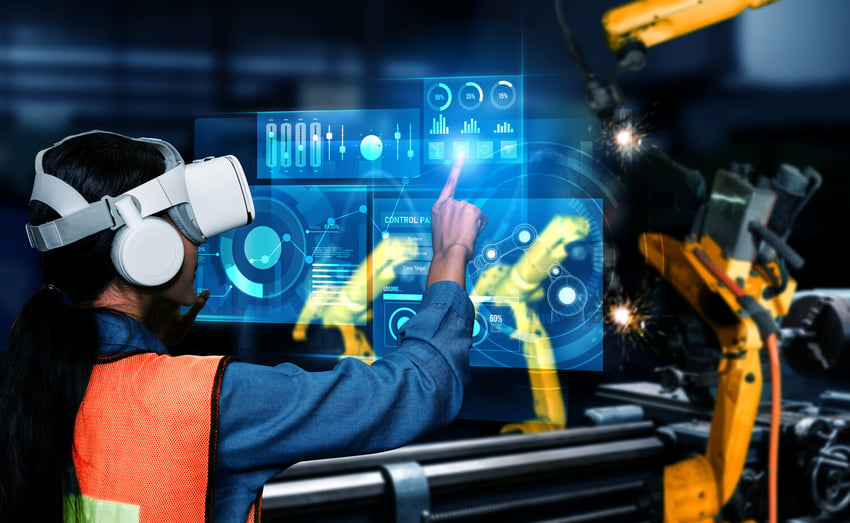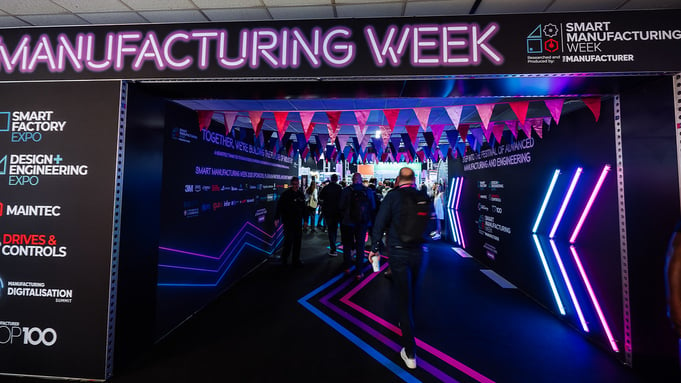Manufacturing Predictions for 2025

As 2025 kicks off, we’re looking ahead to see that manufacturing is on the precipice of a profound transformation. As manufacturers ourselves, we keep our finger on the industry pulse and have been evaluating the emerging trends to form key predictions that we think will shape the future of the sector.
Over the past few years, manufacturers have made significant strides in embracing digital technologies, navigating economic uncertainties, rising costs, and an increasingly challenging business environment. This evolution, driven largely by the rise of Industry 4.0, is set to redefine how manufacturing operates.
The rise of smart factories and automation
One of the most significant shifts occurring in manufacturing today is the widespread adoption of smart factories and automation technologies. According to Deloitte's Digital Maturity Index survey, 98% of surveyed manufacturers have already started their digital transformation journey. This widespread adoption is a clear sign of the industry's ongoing commitment to boosting cost optimisation, operational efficiency, product innovation, and enhancing customer experiences.
Looking at 2025 and beyond, automation levels in factories are expected to rise sharply from 69% to 79% over the next decade. Automation is no longer just about robots on the production line; it’s about creating interconnected systems that enable manufacturers to improve efficiency at every touchpoint.
Smart factories will leverage artificial intelligence (AI), machine learning (ML), and the Internet of Things (IoT) to create highly adaptive, self-optimising production environments. These environments will not only reduce human error and downtime but also create new opportunities for predictive maintenance.
The global adoption of Automated Guided Vehicles (AGVs) in manufacturing is set to experience rapid growth with a compound annual growth rate (CAGR) of 14% over the next five years. Driven by AI and ML advances, AGVs are now smarter, more autonomous, and increasingly efficient.

Among the various types of AGVs, tow vehicles (also known as tugger AGVs, towing AGVs and tow tractor AGVs) are predicted to dominate. Towing AGVs are particularly effective at transporting heavy materials across production facilities, due to their ability to move multiple carts or trolleys at once. This significantly enhances operational efficiency by consolidating multiple transport tasks into a single operation.
By reducing the number of individual trips required, towing AGVs minimise traffic congestion within production facilities, optimise labour utilisation, and decrease the overall transportation time. As factories become more interconnected, AGVs are set to be a significant contributor to the rise of automated production environments.
Predictive maintenance, in particular, will be a game-changer for manufacturers. By using sensors and data-driven automation, manufacturers can monitor equipment in real-time and detect potential issues before they become major problems. This will help reduce unscheduled downtimes, improve operational efficiency, and shrink maintenance costs. Through intelligent automation, factories will become increasingly resilient, reducing the risk of operational disruption.
Digital twins and the metaverse
Another exciting trend on the horizon is the use of digital twins and the metaverse in manufacturing. Digital twins (virtual replicas of physical assets or processes) will allow manufacturers to monitor and simulate their operations in real-time. In 2025, manufacturers will increasingly rely on metaverse-based tools to enhance employee training, perform virtual testing, and monitor factory performance from anywhere in the world.
The potential for virtual collaboration and remote diagnostics will reduce downtime, enhance decision-making, and offer more immersive experiences for both workers and customers. Deloitte’s report reveals that 29% of surveyed companies were already experimenting with digital twins and 3D modelling, with 20% having implemented across multiple projects or processes.
The metaverse is also expected to completely overhaul customer experience for manufacturing sectors. In the near future, we expect to see next-gen manufacturing capabilities integrated into customer experience hubs. These hubs will allow potential customers to experience products and production processes firsthand, bridging the gap between production and customer engagement in ways never before seen.
Sustainability and clean technology manufacturing
Sustainability is no longer just a buzzword; it’s a critical focus for manufacturers as they face growing pressure from customers, governments, and regulators to meet environmental, social, and governance (ESG) goals. In 2025 and beyond, we expect to see even greater investment in clean technology manufacturing, with companies prioritising products and innovations that will help their customers meet emissions reduction targets and promote carbon neutrality.
Manufacturers will increasingly embrace sustainable production practices, such as energy-efficient systems, resource optimisation, and waste reduction technologies. Many businesses are already reducing their reliance on diesel operated (or industrial combustion engine) material handling equipment, such as forklift trucks, and are instead opting for electric solutions.
By also leveraging advanced technologies like AI and machine learning, manufacturers can further enhance their sustainability efforts by optimising energy consumption, reducing material waste, and improving overall production efficiency.
The role of AI and generative AI
Artificial intelligence (AI) will continue to play a key role in the transformation of manufacturing. AI is already embedded in industrial systems and this will only increase, driving operational efficiency and innovation. One of the most impactful uses of AI in manufacturing is the development of intelligent, adaptive systems that can autonomously adjust production processes in real-time.
![]()
For example, in highly specialised sectors like semiconductor manufacturing, precision is key. AI-driven systems will be able to continuously monitor and adjust production parameters to ensure optimal performance, reducing waste and improving product quality.
However, the growing reliance on AI also brings about important ethical considerations. Manufacturers must ensure transparency and accountability in AI-driven decision-making to maintain trust with customers and stakeholders. As AI becomes more embedded within manufacturing processes, it will be crucial for companies to implement frameworks that ensure fair and ethical use of AI technologies.
Addressing the skills gap
Despite the continued investment in automation and AI, the manufacturing sector still faces a significant talent gap. As technology becomes more sophisticated, there is a growing need for skilled workers in these high-tech environments. 97% of UK manufacturers alone report that hiring and retaining skilled labour is a significant challenge to their business growth.
Manufacturers will need to continue developing long-term talent strategies for upskilling current employees and attracting new talent with expertise in digital technologies. In 2025, manufacturers will increasingly turn to advanced training programs and digital tools, such as augmented reality (AR) and virtual reality (VR), to provide employees with immersive, hands-on learning experiences to address the skills gap and ensure that workers are equipped to thrive in a digital-first manufacturing environment.
Employee safety is safeguarding future growth
Less of a trend for the manufacturing industry and more of a continued focus that is vital for manufacturers looking to future-proof their success, the importance of employee health and safety will only continue to increase. As businesses head into 2025 and beyond, the focus is shifting from reactive safety measures to proactive and data-driven solutions that not only protect workers but also enhance overall operational efficiency.
Wearable technology is allowing manufacturers to monitor employee health in real-time. By tracking factors such as movement, heart rate, and even posture, manufacturers can identify risks before they escalate such as detecting early signs of fatigue or exposure to unsafe handling practices.

Manufacturers are increasingly turning to mechanical and automated solutions to proactively reduce physical strain and improve safety. Electric tugs, for example, allow workers to safely move heavy materials with little to no effort or strain, reducing the risk of manual handling injuries and improving operational efficiency.
An increasing number of businesses are looking to go 'forklift free', with retail orders of forklift trucks down by 28% - the biggest decline annually for 14 years - leading many companies to turn to alternative material handling solutions such as electric tugs. With no costly and time-consuming operator licenses required, electric tugs mean anyone within the site can safely move loads;
Electric tugs provide a safe, efficient, and versatile solution for moving heavy loads, eliminating the tipping risks associated with forklifts and offering superior visibility and operator control. They require no license to operate and are suitable for a wide range of applications, from small carts to large trailers, making them ideal for manufacturers transporting heavy or diverse loads.
The move to implement more forklift-free areas and segregate forklifts from pedestrian zones is a trend set to continue for manufacturing in particular, as businesses turn their focus on maximising staff safety.
Ready for the future of manufacturing?
The manufacturing sector is set to continue evolving at a rapid pace. The growing adoption of automation, AI, and digital technologies will enable manufacturers to improve operational efficiency, reduce costs, and stay competitive in an advancing global marketplace. At the same time, manufacturers will need to be placing their focus on workplace safety, sustainability, and talent development to ensure long-term success.

About the author
James Jones
With a Master of Engineering (Meng), James is our in-house automation and custom solutions expert. As Partner, James plays a pivotal role in driving the company's growth and development



